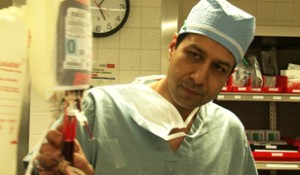- Home
- Activism
- Crime & Courts
- Economics
- Education
- Environment & Climate Change
- Gun Control
- Healthcare
- History
- Human Interest / Inspirational
- LGBT Issues
- Politics
- Racial Issues
- Rants / Op-Eds
- Religion
- Right-Wing Hatred
- Social Issues
- States Issues
- The War on Drugs
- Veterans Issues
- Weird News
- Women's Issues
- World News
FDA Approves Human “Suspended Animation” Trials
Remember way back in 2002 when cell phones still looked like this? Apparently, science was approaching the future at a much steadier pace than we thought. Twelve years ago, at the University of Michigan Hospital, Doctor Hasan Alam was already working on developing a technique for “emergency preservation and resuscitation”, better known among the sci-fi community as “suspended animation“. The original study, which can be accessed here, was conducted on pigs.

Hasan Alam, MD. starring in an episode of “Boston Med”
Basically, the pigs were drugged and given massive hemorrhages (simulating the effect of a lethal gunshot wound). Their blood was replaced with a cold saline solution, ceasing cellular activity, and effectively shutting down the pig’s entire body - including the heart. During this part of the process, the pig’s temperature would be lowered to around 10°C (50°FÂÂÂ), a far drop from the healthy temperature of 40°C (104°F). The injury was treated within a few hours, and the saline solution would be replaced by blood. The heart would usually resume beating on it’s own - although a few pigs required a jump start - and despite the temporary death, “learning and memory (was) preserved”.
So why exactly does this technique work?
At the standard temperature of 37°C (98.6°F) cells require a constant stream of oxygen to maintain the chemical reactions that keep us alive. If the heart stops beating, the blood stops flowing, and cells don’t receive any oxygen. Five minutes later, the brain begins to die. When the body is so drastically cooled, almost all cell activity stops, and the cells take far longer to deteriorate. This is why patients who drown in icy water are able to be resuscitated after periods of half an hour or more, the longest case being a two-year-old who was submerged in an icy lake for 66 minutes.
Now that the trials have been so successful in the animal testing stage, it’s time to move on to humans. A prepared team of doctors, led by Samuel Tisherman, at the UPMC Presbyterian Hospital in Pittsburgh are about to receive the go-ahead to attempt the procedure on humans, after a final meeting this week. It will be very similar to the treatment on pigs, with a few exceptions.
Doctors will not be choosing their patients. Instead, they will wait for the right one to come along. The patient will arrive at the hospital’s emergency room, having obtained a traumatic injury. At some point, whether in the ambulance or at the hospital, the patient will have suffered cardiac arrest. The patient will not respond to attempts to start the heart, and their chance of survival will be less than 7 percent.
At this point, the team will be paged, and begin the procedure. A “NewScientist” article explains the procedure in detail:
The first step is to flush cold saline through the heart and up to the brain – the areas most vulnerable to low oxygen. To do this, the lower region of their heart must be clamped and a catheter placed into the aorta – the largest artery in the body – to carry the saline. The clamp is later removed so the saline can be artificially pumped around the whole body. It takes about 15 minutes for the patient’s temperature to drop to 10 °C. At this point they will have no blood in their body, no breathing, and no brain activity. They will be clinically dead.
…The patient will be disconnected from all machinery and taken to an operating room where surgeons have up to 2 hours to fix the injury. The saline is then replaced with blood. If the heart does not restart by itself, as it did in the pig trial, the patient is resuscitated. The new blood will heat the body slowly.
Since it’s impossible for a patient to sign a consent form in these circumstances, no consent will be required. Instead, the hospital will be releasing a notice to the community, allowing members to come forward ahead of time and ask to be excluded from the study if they become eligible in the future.  Ten patients will be tested, followed by a possible readjustment of the procedure. Patients will continue to be treated in increments of ten before the study is eventually expanded to include other hospitals.
For now, Tisherman hopes the new procedure will be able to save people who would have had no chance in the past.
This is for a patient whose injuries are fixable if you can stop the clock, buy time, and get the person to the surgeon. Our hope is that we can save some people we can’t right now.
